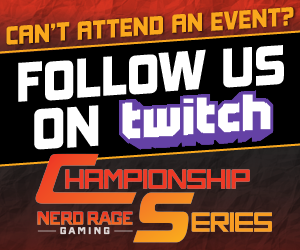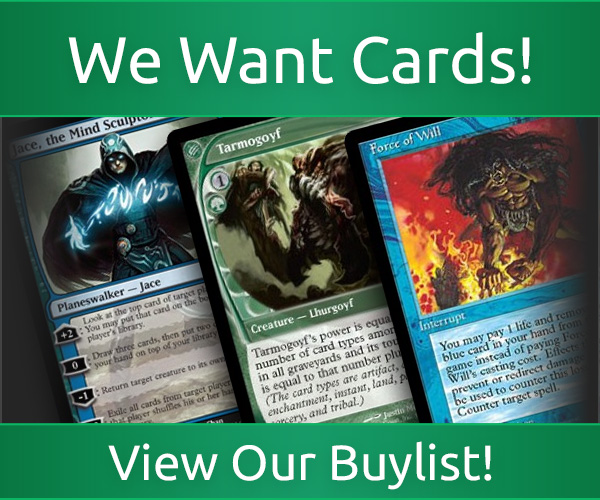The State of Modern: Dredge, by Mat Bimonte
Dredge is the best deck in Modern.
There, I said it.
There is a reason I have been doing nothing but casting Cathartic Reunions and Faithless Lootings for the last few months. While this deck is very difficult to play optimally, it is in my opinion the best Game 1 deck in all of Modern, even surpassing Affinity for that title.
Dredge takes advantage of an unprepared metagame. Most decks are packing Terminate, Fatal Push, and Lightning Bolt in order to deal with the vast majority of the decks Modern has to offer. If you are killing creatures from Dredge, they will more than oblige and recur them as the game progresses. Dredge also takes advantage of the fact that most mana bases in Modern are going to do somewhere between 3-6 damage to themselves throughout the course of a game, making Conflagrate a very real card.
Let’s dive in to where I would start if I had a tournament today. This is actually the decklist I registered for last weekend’s Team Constructed CTQ in Moline:
Dredge, by Mat Bimonte
This list is pretty straightforward and very similar to what I have been playing for a few months.
The Untouchables
Almost everything
This deck is honestly a masterpiece. It’s very hard for me to find any reason to cut the enabling cards, and I don’t think Dredge is a mechanic Wizards of the Coast should, or will, be revisiting anytime in the near future. With a deck like this, most of it is carefully crafted to enable your Dredging, so it is easier for me to tell you what cards are able to be flexed within the 60.
The Flex Slots
As I stated above, most of the 60 card main deck for Dredge is locked in. There is a small bit of room for flexibility, and these are the slots:
4x Insolent Neonate
2x Golgari Thug
2x Collective Brutality
1x Haunted Dead
Golgari Thug vs. Darkblast: The “extra dredger” in the deck. This slot is sometimes occupied by Darkblast, which essentially does the same thing with fewer cards entering your graveyard, but it does give you better game as recurring removal against things like Infect (if that exists), Affinity, and Elves if those decks are a major part of the metagame.
in the deck. This slot is sometimes occupied by Darkblast, which essentially does the same thing with fewer cards entering your graveyard, but it does give you better game as recurring removal against things like Infect (if that exists), Affinity, and Elves if those decks are a major part of the metagame.
Insolent Neonate vs. Collective Brutality: This is one of the newer debates amongst Dredge players. Ben Friedman actually started this by playing four Collective Brutality in the main deck over the four Insolent Neonates a while back. While this allows you to be better against spell-based combo and Collected Company decks, it makes you much less explosive than the Turn 1 Neonate, sacrifice discarding Stinkweed Imp, dredge Stinkweed Imp hands allow you to be. Ben likes his deck to be a little more grindy than explosive, but I enjoy having access to more explosive starts. Collective Brutality is good enough to find spots for in my build, but not at the expense of Neonate.
Haunted Dead vs. Rally the Peasants/Scourge Devil: All of these cards have activated abilities from your graveyard. I prefer Haunted Dead in this slot as it is first and foremost a blocker. It is also a card you can cast from your hand sometimes in post board games that go longer. When I was playing Rally or Scourge Devil, they always felt like “win more” cards to me, and when Dredge is winning, it is already dealing damage in consistent large chunks. There is no need for overkill over consistency of discarding your extra dredgers.
The Manabase
This is yet another hotly contested point among Dredge players. As you can see, my manabase is full of fetchlands and shocklands. While you are sacrificing your life total a bit, you are also able to play around cards like Anger of the Gods and Relic of Progenitus much better with this land base, because it lets you hard cast your creatures. The inclusion of one Steam Vents is also nice to be able to go get at any moment in order to hard cast Narcomoeba and Prized Amalgam. It also lets you cast Engineered Explosives from your hand for one more color of mana should you see a problematic permanent.
The less threatening mana base includes Gemstone Mine as a “rainbow land” for the deck. While I’ve played this mana base before, I always felt like I had less targets for Life from the Loam to retrieve. Each manabase has positives and negatives, and you should try out both before entering a tournament to get a feel for them.
Gameplay
How do matches usually play out? For starters, the baseline keep for Dredge is two lands (one has to produce green), a dredger, a discard outlet, and three other cards that essentially don’t matter. Preferably they do things in the graveyard after you discard them, but it’s not the biggest of deals.
For starters, the baseline keep for Dredge is two lands (one has to produce green), a dredger, a discard outlet, and three other cards that essentially don’t matter. Preferably they do things in the graveyard after you discard them, but it’s not the biggest of deals.
Having the green source is very important, as Life from the Loam is one of your most important cards. Typically you are wanting to get a dredger in the bin as quickly as possible, and you want to be dredging each turn instead of drawing a card. Remember, your graveyard is an extension of your hand, so be comfortable with how your graveyard is arranged to be certain you aren’t missing things.
Within your first two dredges, you should be working your way to getting power on the board. Dredge is almost always attacking, as trading your creatures for your opponent’s is almost certainly great since yours rise from the dead. Often you will have a choice on which card you would like to dredge. Sometimes you need Dakmor Salvage to trigger Bloodghast. Sometimes you need Stinkweed Imp as a blocker or to put more cards in the bin. Sometimes you want to refuel your hand with Life from the Loam to kill them with Conflagrate. Once you’ve dealt enough chip damage, and your opponent has damaged themselves with lands, it’s time to start Loaming. I’ve Conflagrated someone for as much as 11 before. Remember you’ll want to Conflagrate main phase if it turns your Bloodghasts into hasty creatures. Dredge is fairly straight forward in that regard.
Some small sequencing things to keep in mind, though. Dredge is a deck that is also very mechanically intensive. Be sure to be discarding and dredging before playing a land for the turn. There is nothing like having egg on your face when you hit Bloodghasts with your discard or dredge effects, and have already played a land for the turn. Remember if you have a Prized Amalgam trigger at endstep, it triggers new ones as well that might not have received a trigger previously.
Sideboarding
Zen Takahashi wrote an incredibly comprehensive sideboarding guide which you can find here:
http://www.mtgmintcard.com/articles/writers/zen-takahashi/the-ultimate-dredge-sideboard-guide
I don’t have a ton of insight to add without telling you that his guide is one of the many resources I used when learning Dredge. What I can offer you is that your sideboard cards can adapt to the metagame you are expecting. Tons of small creatures? More Darkblast. Lots of combo decks? More hand disruption. Lots of fatties? More Lightning Axe.
I can also tell you that in sideboarding with this deck, even more than others, less is more. Don’t go crazy and board in 15 cards. Your deck is a well-oiled machine, and removing too many of the cogs will cause you to sputter out. You will notice that people will mulligan a lot against you trying to find sideboard cards, and when they do find them, that is ok. Sometimes they have them and not enough lands. Sometimes they aren’t fast enough. You can maneuver around sideboard cards, and learn how to better do it with more reps. Do not over-board, and remember your deck is the best mulliganing deck in the format, so don’t keep non functional hands.
Good Matchups
Let’s begin with the good matchups for Dredge. Most decks that are slow developing or don’t have access to large blockers are very favorable for Dredge. You are winning almost every game 1 anyways, just due to the nature of your deck versus the field. Slow developing decks allow you to put somewhere between 4 and 10 power on the board on average by turn 3. In fact, them killing your early plays is mostly just them spinning their tires before your undying army eventually overwhelms them in the end.
Decks I consider very positive Game 1 are:
Burn
Death’s Shadow variants
Various control decks
Eldrazi Tron
Bad Matchups
Main deck configurations of spell based combo decks are going to be hard depending on how well your first dredges hit. I consider Ad Nauseam, Storm, and Lantern Control to be negative matchups game 1.
Now here is where it gets tricky. I can tell you that every single deck in Modern is going to be a bad matchup for you post board, and that is going to be true to some extent. Dredge is a deck that feeds off of your opponents not respecting you before the tournament even starts. Obviously dedicated hate cards such as Rest in Peace, Grafdigger’s Cage, Relic of Progenitus, and Surgical Extraction are doing to be hard to deal with, but not everyone is showing up with heaps of those cards in their sideboard, and to be frank, why would they? Dredge is one of the least represented archetypes in Modern currently. The trick to becoming a great Dredge player and winning matches is managing against the hate cards.
Wrap Up
I’ve had a ton of fun learning the ins and outs of Dredge. It is one of the more complex decks in the format, as it uses a mechanic not often seen. It is also a very rewarding archetype if you are mechanically inclined, and don’t mind folding to a few hate cards. While I’ve had my fair share of Rest in Peace for a while, and am probably playing something else at the Nerd Rage Gaming CT this weekend, Dredge is almost always going to be a great choice to play, if you are willing to put in the work. As always if you have any questions or comments regarding the deck, I am always available to chat. Come say hi this weekend, and good luck (unless it’s against me)!
Thanks for stopping by,
Mat Bimonte
Mat Bimonte first picked up the game during Theros block, but already has a Modern 5K championship under his belt, as well as a number of smaller Standard tournament wins. Based out of Bloomington, Ill., Mat is a regular on the SCG Tour, with future aspirations of qualifying for the Pro Tour.




